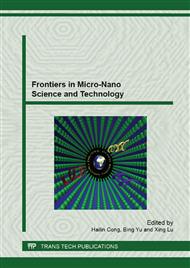[1]
B. Bhushan, Nano-tribology and nano-mechanics, Wear. 159 (2005) 1507-1531.
Google Scholar
[2]
C. Viti, T. Hirose, Thermal deformation of serpentine during coseismic faulting: Nanostructures and mineral reactions, J. Struct Geol. 32 (2010) 1476-1484.
DOI: 10.1016/j.jsg.2010.09.009
Google Scholar
[3]
S. Y. Tarassov, A. V. Kolubaev, Effect of friction on subsurface layer microstructure in austenitic and martensitic steels, Wear. 231 (1999) 228-234.
DOI: 10.1016/s0043-1648(99)00107-6
Google Scholar
[4]
Y. Sun, L.S. Shu, X. C. Lu, H. Liu, X. H. Zhang, A. M. Lin, K. Kasaka, Recent progress in studies on the nano-sized particle layer in shear planes, Progress in Natural Science. 18 (2008) 367-373.
DOI: 10.1016/j.pnsc.2007.12.001
Google Scholar
[5]
N. Keulen, R. Heilbronner, H. Stunitz, A-M. Boullier, Grain size distributions of fault rocks: Acomparison between experimentally and naturally deformed granitoids, Jour Stuct Geol. 29 (2007) 1287-1300.
DOI: 10.1016/j.jsg.2007.04.003
Google Scholar
[6]
H. Arora, P. Du, K.W. Tan, Block Copolymer Self Assembly-Directed Single-Crystal Homo-and –Heteroepitaxial Nanostructure, Science. 330 (2010) 214-217.
DOI: 10.1126/science.1193369
Google Scholar
[7]
A.M. Schleicher, V. Pluijm, L.N. Warr, Nano-coating of clay and creep of the San Andress fault at Parkfield California, Geology. 38 (2010) 667-670.
DOI: 10.1130/g31091.1
Google Scholar
[8]
R. Han, T. Hirose, T. Shimamoto, Y. Lee, J-i. Ando, Granular nano-particles lubricate faults during seismic slip, Geology. 39 (2011) 599-602.
DOI: 10.1130/g31842.1
Google Scholar
[9]
M.F. Jr., Hochella, S.K. Lower, P.A. Maurice, Nano-minerals, Mineral Nano-particles and Earth Systems, Science. 319 (2008) 1631-1635.
Google Scholar
[10]
C. Fradin, A. Brasian, Reduction in the surface energy of liquid interface at short length scale, Nature. 403 (2000) 871-874.
Google Scholar
[11]
O.M. Braun, A.G. Naumovets, Nano-tribology: Microscopic mechanism of friction, Surf Sci. Rep. 60 (2006) 79-158.
Google Scholar
[12]
K. Mair, M. Fiye, C. Marone, Influence of grain characteristics on the friction of granular shear zones, Jour Geophy Res. 107 (B10) (2002) 1-9.
DOI: 10.1029/2001jb000516
Google Scholar
[13]
F. Fussis, M.R. Handy, Micro-mechanisms of shear zone propagation at the brittle-viscous transition. Jour Struct Geol. 30 (2008) 1242-1253.
DOI: 10.1016/j.jsg.2008.06.005
Google Scholar
[14]
Y. Mo, K.T. Turner, I. Szlufarska, Friction lows at the nano-scale, Nature (Letter). 457 (2009) 1116-1119.
Google Scholar
[15]
M. Pier, L. Burlini, L. Kunze, Rheological and micro-structural evolution of Carara marble with high shear strain: Result from high temperature torsion experiments. Jour Struct Geol. 23 (2001) 1392-1413.
DOI: 10.1016/s0191-8141(01)00006-2
Google Scholar
[16]
J. Tullis, Deformation of granitic rocks: Experimental studies and natural example, Reviews in Mineralogy and Geochemistry. 51 (2002) 51-96.
DOI: 10.2138/gsrmg.51.1.51
Google Scholar
[17]
R. Han, T. Shimamoto, T. Hirose, J-H. Ree, J-I. Ando, Ultra low friction of carbonate fault caused by thermal decomposition, Science. 36 (2007) 878-881.
DOI: 10.1126/science.1139763
Google Scholar
[18]
Y. Sun, S.Y. Jiang, W. Zhou, X. C. Lu, Nano-coating texture on the shear slip surface in rocky materials, Advanced Materials Research. 669 (2013) 108-114.
DOI: 10.4028/www.scientific.net/amr.669.108
Google Scholar
[19]
C. Collettini, R-H. Sibson, Normal fault, normal friction, Geology. 29 (2001) 927-930.
DOI: 10.1130/0091-7613(2001)029<0927:nfnf>2.0.co;2
Google Scholar
[20]
O. Ben-David, G. Cohen, J. Finebery, The Dynamics of the Onset of Frictional Slip, Science. 330 (2010) 211-214.
DOI: 10.1126/science.1194777
Google Scholar
[21]
P. Xypolias, Some new aspect of kinematics vorticity analysis in naturally deformed quartzites, Jour Struct Geol. 31 (2009) 3-10.
DOI: 10.1016/j.jsg.2008.09.009
Google Scholar
[22]
L. Ru, B L. Hao, X. S. Cheng, Phase transitions and phase phenomena (in Chinese), Beijing: Science Press. (2006) 1-236.
Google Scholar
[23]
J. Escartin, M. Andreari, G. Hirth, B. Evans, Relationship between the micro-structural evolution and the rheology of talc at elevated pressure and temperatures, Earth and Planetary Science (Letters). 268 (2008) 463-475.
DOI: 10.1016/j.epsl.2008.02.004
Google Scholar
[24]
C. Viti, T. Hirose, Dehydration reaction and micro/nano-structures in experimentally deformation serpentinites, Contrib. Mineral Petrol. 157 (2009) 327-338.
DOI: 10.1007/s00410-008-0337-6
Google Scholar
[25]
W. L. Guo, H. Dong, M. Lu, The coupled effects of thickness and delamination on cracking resistance of X70 pipeline steel, Inter Jour of Pressure Vessels and Piping. 79 (2002) 403-412.
DOI: 10.1016/s0308-0161(02)00039-x
Google Scholar


